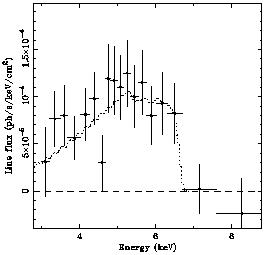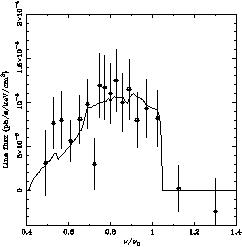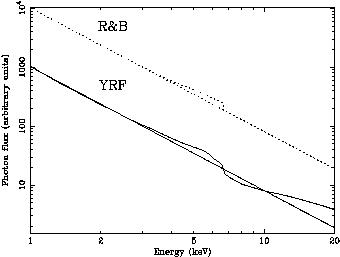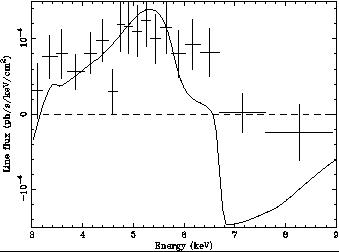


Circular particle orbits around a black hole are only stable outside the radius of marginal stability, rms. Within this radius, it is normally assumed that the material plunges ballistically into the black hole. The location of rms depends on the black hole spin, decreasing from 6 rg for a static Schwarzschild black hole (a/m = 0) to 1.235 rg for prograde orbits around a maximally spinning Kerr black hole (a/m = 0.998). Thus the inner edge of a Keplerian accretion disk will be at rms. In the standard model the X-ray emission from the accretion disk takes place in a (possibly patchy) disk-hugging corona above the (almost) Keplerian part of the disk. The material inflowing within rms cannot support a corona and is assumed to receive an insignificant fraction of the X-ray illumination. In such models fluorescent line emission is expected to extend in only as far as rms.
As discussed previously the degree of redshifting seen in the iron line is an indication of how close the line emitting region extends to the black hole. During a deep minimum in the X-ray light curve of the 1994 ASCA observation of MCG-6-30-15 the iron line was seen to broaden and shift to lower energies (see Fig. 8). The only way to have such significantly redshifted line flux is for the source of emission to move within the innermost stable orbit for a static Schwarzschild black hole (i.e. 6 rg). The line is well fit by the profile of a maximally spinning Kerr black hole leading to the tentative conclusion that the line was the first spectroscopic evidence for a Kerr black hole (Iwasawa et al 1996). (It was tentative because of the difficulty in measuring the continuum precisely at that time due to an increase in the strength of the warm absorber; Otani et al 1996). Later work by Dabrowski et al (1997) quantified the spin of the black hole required to produce such highly redshifted emission to exceed 95 per cent of its maximal value. The equivalent width of the line also increased dramatically (by a factor of 3-4) during this deep-minimum.
Of course, the black hole spin cannot change on such short timescales. It seems, instead, that the pattern of X-ray illumination across the disk must change in the sense that it becomes more concentrated that average during the deep minimum. Since such a dramatic change in illumination pattern is unlikely to occur just by chance, some structural change in the X-ray emitting corona is inferred. A plausible correspondence of the accretion disk thermal timescale, and the timescale on which the source enters the deep-minimum, may suggest that such structural changes are mediated by thermal instabilities in the accretion disk or accretion disk corona. An unsolved problem of this model is that one would expect the continuum level to increase significantly (rather than suffer the observed decrease) when the emission is originating from the energetically-dominant, innermost regions of the accretion disk.
Reynolds & Begelman (1997) have pointed out that although the inner edge of the accretion disk around a Schwarzschild (i.e. non-rotating) black hole is at 6 rg the accretion flow does not immediately become optically thin at smaller radii, and may remain optically thick almost all the way down to the horizon. If this it is illuminated in the right manner, ionized iron fluorescence from this region can give rise to an extremely broad and highly redshifted iron line very similar to that observed during the deep minimum (see Fig. 9). In this model, the illuminating source is assumed to be a point source located on the symmetry axis of the accretion disk. The change in line profile, line equivalent width, and continuum level are explained by assuming that the X-ray source changes its height above the accretion disk with approximately constant luminosity. However, the modelling of Reynolds & Begelman (1997) did not account for the Compton reflected continuum which would be expected to accompany the line. Young, Ross & Fabian (1998) have computed both the line and continuum spectrum expected from such a model. Within 6m the density of the infalling material drops rapidly and it becomes photoionized by the X-ray illumination, generating a large iron absorption edge (see Fig. 10). Preliminary indications suggest that such an edge may not be present in the data, although detailed spectral fitting has yet to be performed in order to address this issue. While the situation with current data remains ambiguous, searching for these type of spectral features in future XMM-Newton data may allow us to unambiguously determine the spin of the black hole in MCG-6-30-15 and other objects.

|

|
Figure 9. The broad and highly redshifted iron line profile of MCG-6-30-15 observed during a deep minimum in its light curve. The left panel shows the line profile from a maximally spinning Kerr black hole (dotted line; see also the lower left panel of Fig. 8), and the right panel shows the line profile from a static Schwarzschild black hole using the model of Reynolds & Begelman (1997). |

|

|
Figure 10. The modeling of Reynolds & Begelman (1997) does not take into account the Compton reflected continuum that accompanies the line. The left panel shows a comparison of their model (R&B) with one in which the full reflected continuum has been taken into account (YRF; Young, Ross & Fabian 1998). The reflected continuum should posses a strong absorption edge that tentatively appears to be inconsistent with the data (right panel), although future observations are required to unambiguously determine the spin of the black hole. |
The detailed nature of the accretion flow within 6 rg of a Schwarzschild black hole is likely to be a lot more complicated than we have assumed in the above discussion. Magnetic fields within the innermost stable orbit may be rapidly amplified until their energy density is comparable to the rest-mass energy density of the accretion flow (Krolik 1999), and hence will be dynamically significant. Such strong field enhancement within the radius of marginal stability may lead to the creation of an ``inner'' X-ray emitting corona (note that Lee et al. 2000 have argued for an inner, highly variable, X-ray corona on the basis of the observed RXTE variability). The presence of magnetic fields may also exert a torque on the inner edge of the disk (usually assumed to have a zero-stress boundary condition) thereby increasing the outward flow of angular momentum and the efficiency of the disk (Agol & Krolik 2000; although also see Paczynski 2000 for an opposing view). If there is appreciable line fluorescence from within the radius of marginal stability, reverberation mapping (discussed below) may allow this region to be mapped out in detail.